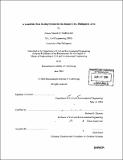A landslide risk rating system for the Baguio City, Philippines area
Author(s)
Saldivar-Sali, Artessa Niccola D., 1980-
DownloadFull printable version (19.23Mb)
Other Contributors
Massachusetts Institute of Technology. Dept. of Civil and Environmental Engineering.
Advisor
Herbert H. Einstein.
Terms of use
Metadata
Show full item recordAbstract
This research formulates a LANDSLIDE RISK RATING SYSTEM for the Greater Baguio area in the Philippines. It is hoped that the tool will be made a part of the physical/urban planning process when used by engineers and planners and used to address risks posed by landslides given the rapidly increasing concentration of population and the development of infrastructure and industry in the Baguio area. Reports and studies of individual landslides in the area are reviewed in order to discover the causal factors of mass movements and their interactions. The findings of these research works are discussed in the first portion of this paper. A description of the LANDSLIDE RISK RATING SYSTEM, remedial measures, and recommendations form the rest of the paper. This SYSTEM integrates different hazard (bedrock geology, slope gradients, vegetation) and risk (population, land use) factors. The selection of hazard factors takes into account the results of the analysis of causal factors of mass movements in the area. This analysis is based on the specific attributes of the subject study area, namely: a relatively extreme topographic relief, variable bedrock geology, and no significant differences in rainfall from one zone to another. The study assumes that the entire Greater Baguio area is subject to a uniform amount of rainfall during any given precipitation event. Although this study is area-specific it can have wider application. (cont.) Finally, the paper recommends that in future research work on this subject matter, soil and rock samples from various slopes be subjected to geomechanical testing to facilitate a mathematical analysis of slope failures. This can be the basis for a comprehensive database which can be used to create a Landslide Hazard Map where each slope in the Greater Baguio area can be rated. In addition, it would be beneficial to conduct an analysis of how Hazard Ratings may be reduced when particular remedial measures are in place. A site-specific preventive and remedial slope safety system for every slope in the Greater Baguio area would be the ultimate goal of future work.
Description
Thesis (M. Eng.)--Massachusetts Institute of Technology, Dept. of Civil and Environmental Engineering, 2004. Includes bibliographical references (leaves 154-156).
Date issued
2004Department
Massachusetts Institute of Technology. Department of Civil and Environmental EngineeringPublisher
Massachusetts Institute of Technology
Keywords
Civil and Environmental Engineering.